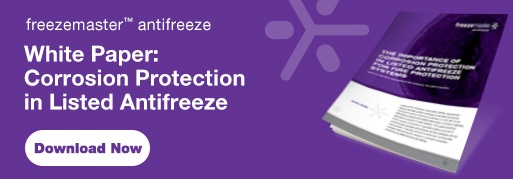
By: Mark Knurek on September 30th, 2019
UL 2901 and Fire Sprinkler System Antifreeze Corrosion Issues
UL 2901 was established in December 2013, outlining certification requirements for antifreeze solutions for wet pipe fire sprinkler systems. To meet the UL 2901 requirements, antifreeze products must prove corrosion resistance (important for metal-based fire sprinkler systems), fire performance (i.e., flammability), hydraulic characteristics, human health and environmental impact, and meet marking and installation specifications.
UL 2901 and the resulting changes to NFPA 25 were in direct response to fires caused by improperly mixed glycerin-based and propylene glycol-based antifreeze solutions. Both agents were mixed in concentrations above the prescribed levels, actually intensifying the fires when the sprinkler systems were activated.
While flammability was a primary concern, the new UL standard also addressed the issue of the corrosion that antifreeze may cause to sprinkler systems using steel pipes.
This is significant, because NFPA 25 states that all traditional glycerin and propylene glycol antifreeze products may no longer be used by September 30, 2022. These products must be replaced by a premixed, agency listed solution by that date.
UL 2901 and Corrosion
Water-filled metallic piping systems of any kind – including steel – are subject to corrosion. Steel piping corrosion eats away at the interior of a pipe, and that creates friction, slowing the water flow in the event of an emergency. Corrosion can also create pinholes that, in the case of a fire sprinkler system, could lead to complete system failure, negating the system’s ability to suppress fires.
Antifreeze solutions, particularly glycerin-based – even factory premixed – can add to the acidic effects of sprinkler system water and magnify the corrosive effects within the system. Site-mixed concentrations, with the potential for overmixing, can take the issue a step further. This problem is worsened in the case of systems that are not airtight.
Severely discolored antifreeze, often found when systems are drained for service, is an obvious sign that corrosive action has set in.
UL 2901 establishes testing protocols to ensure that the corrosion rates and pit depth corrosion in metal-based sprinkler systems are significantly reduced. To meet these protocols, premixed antifreeze solutions must not cause the corrosion to exceed 1.0 mils/year (0.025 mm/year) for ASTM A108, Grade 1010 steel; ASTM B16, H02 (Half Hard) brass; Type 304 stainless steel, and additional representative metallic materials other than these or any metallic plating referenced in the manufacturer’s instructions as being compatible with the antifreeze solution.
Note the key word – premixed. NFPA 25 requires premixed antifreeze solutions to eliminate the potential risk of overmixing onsite.
freezemasterTM Antifreeze Offers Superior Corrosion Resistance
freezemasterTM antifreeze protects fire sprinkler systems against corrosion and from freezing in temperatures as low as -12°F (-24°C). It is developed, engineered and manufactured in America by Lubrizol Advanced Materials, a specialty chemical company with more than 30 years of fire safety expertise.
freezemasterTM antifreeze is a factory premixed antifreeze that helps to prolong steel pipe-based fire sprinkler system integrity, allowing the system to protect people and property when sprinklers activate in a fire. It can be installed and serviced in all new and existing fire sprinkler systems for Residential, Light Hazard, Ordinary Hazard and Storage applications to help meet requirements for NFPA 13, 13R, 13D and 25, including at volumes up to 500 gallons for NFPA 13 (Light Hazard) systems. (Refer to the freezemasterTM antifreeze Installation Guide for design parameters and listing limitations.) Because it is dyed blue for easy identification of a fully flushed and filled system, installers are saved from having to constantly test a clear fluid.
It also is formulated with a superior corrosion inhibitor compared to listed alternatives, thus offering a lower total cost of ownership than other commercially available freeze protection methods.



